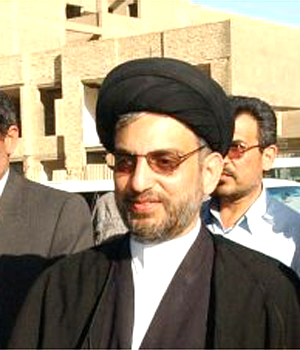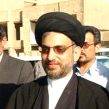
The Hakim-Sadr Pact: A New Era in Shiite Politics?
Publication: Terrorism Monitor Volume: 5 Issue: 20
By:

The recent “pact of honor” made by two of Iraq’s most influential Shiite clerics, Moqtada al-Sadr and Abdul Aziz al-Hakim—aimed at preventing violence and helping to maintain the “Islamic and national interest” of Iraq—appears to signal a significant shift toward stability in Iraq. The two leaders have pledged to enhance relations between their respective groups, merging media and cultural projects, and to refrain from launching negative propaganda against each other (Fars News Agency, October 6). Yet, more importantly, the pact calls for promotion of the legal-political order of post-Baathist Iraq, a major move that could give new life to Nuri al-Maliki’s government and curtail potential violence in the south.
As the first official agreement between these two prominent leaders, the forged pact can also be recognized as a huge step in improving intra-Shiite relations. Not since the formation of the United Iraqi Alliance, which brought together a number of Shiite political parties under the spiritual leadership of Ayatollah Ali al-Sistani in 2003, has Shiite politics seen such a unified front. The struggle for domination between rival Shiite groups has caused huge problems in the south, especially after the December 2005 elections. Despite a number of attempts for reconciliation, the enmity between al-Hakim and al-Sadr and their militias has remained a major security problem, especially in the provinces of Basra and Maysan, where the two factions are vying for control over oil and territory.
Disagreements only intensified after the British withdrawal from Basra in early September, causing trouble for an already unstable Iraqi government seeking reconciliation over major political issues such as federalism and the distribution of oil. Seen in such a context, this new deal is made at a time when the “surge” strategy has gradually shown signs of relative military success in places like the eastern and central provinces, where al-Qaeda forces continue to lose the support of Sunni Iraqis. Yet, one important question remains to be answered: does the new pact promise any significant improvement in the country’s political situation at such a crucial stage in its history?
First of all, it is important to note that the meaning of this pact sharply differs for the two rival parties. For the nationalist Sadrists, who view the members of al-Hakim’s Supreme Iraqi Islamic Council (SIIC) as traitors and question their Iraqi credentials because of their close ties to the Iranian government, the deal with al-Hakim signifies an expedient move that can potentially ameliorate the group’s image as an unruly, violent organization. For the leaders of the SIIC, however, who view al-Sadr’s organization as a dangerous movement led by a group of unseasoned young clerics who lack any credible link with the traditional clerical establishment (hawza) in Najaf (or Qom), a pact with al-Sadr can be used to tame Iraq’s most powerful Shiite oppositional organization, hence chipping away at al-Sadr’s popularity by diminishing his organization’s anti-establishment identity.
Although the reconciliatory nature of the deal is hailed as a major rapprochement in Hakim-Sadr relations, the pact rather masks more familiar problems than reveals a new beginning for Iraq’s democratic order. First and foremost, the truce lacks a genuine effort for reconciliation, as the two rival groups still maintain their ideological differences by defining each other as military foes on the street level, rather than as political competitors in the political arena. The deal also shows signs of external manipulation by other major Shiite players, primarily Tehran (and Qom), which is seeking a united Shiite stance against a potential U.S. attack on Iran. As the U.N. Security Council, led by Washington, seeks further sanctions against Iran’s nuclear ambitions, Iranian conservatives and hardliners are raising expectations of greater cohesion between Shiite groups under the leadership of Tehran. A new Iraq dominated by a united Shiite force can serve as a powerful instrument to contain U.S. influence in the region, and al-Hakim and al-Sadr could play a leading role in such an endeavor.
Secondly, the pact can help increase SIIC’s political weight in the parliament ahead of provincial elections planned for next year and, concurrently, decrease al-Sadr’s influence in the al-Maliki government. Despite his popular support in Sadr city and southern cities like Diwaniya and Karbala, al-Sadr’s absence from al-Maliki’s government continues to be a huge blow to his political influence in Baghdad. On an organizational level, the movement has become disoriented and disillusioned, as al-Sadr faces serious allegations of incompetence, especially with signs of trouble in the organization of the Madhi Army that led to its six-month suspension after the breakout of violence against the Badr Organization in the summer of 2007. The pact marks a major turning point for al-Sadr’s movement. For Iran (and also the United States), the ideal way to finally tame al-Sadr is to chip away at his popular base through the electoral and institutional processes, such as the deal with al-Hakim and, accordingly, diminish his status as a charismatic militant leader defiant of institutionalization.
The third factor is the threat of a Sunni-U.S. alliance. Due to the relative military success of U.S. forces in Anbar province, Tehran seems to be mostly worried about the recent partnership forged between U.S. and Sunni Iraqi leaders, especially the tribal chiefs. In this sense, the gradual marginalization of Shiite factions in Baghdad—mainly as a consequence of their own internal divisions—coupled with U.S. support for Sunnis, has created a serious problem for Tehran. The rationale behind Iran’s strategy is to contain the U.S. sphere of influence in Baghdad by keeping the Sunni Arab factions divided in the parliament and making them seem inseparable from militant Salafi forces. What a Shiite united front can do is hold back a unified Sunni front that is increasingly growing closer to the United States.
The role of Najaf, however, is less clear. Although there is no solid evidence of the extent of al-Sistani’s influence, it appears that the grand ayatollah supported the negotiations and most likely initiated the event after the Karbala incident in early September [1]. Al-Sistani’s interest in the pact may be articulated in the following terms: Shiite unity must be preserved under the leadership of Najaf, which is the traditional center of Shiite authority, although Iran may also play a role in attaining this noble objective. Najaf and Tehran, in this sense, both share an interest in containing al-Sadr and his sectarian movement, bringing the organization and other shadowy anti-Najaf movements under the control of the traditional Shiite establishment [2]. This move also signals the extent to which al-Sistani still continues to influence Shiite Iraqi groups, despite Najaf’s loss of authority after the Samarra bombing of 2006 that empowered Shiite militia forces against the threat of militant Salafis. This is good news for Baghdad, since al-Sistani can play a positive role in disarming the Shiite militias and improving Sunni-Shiite relations in the government, especially in light of al-Maliki’s diminishing authority since the withdrawal of a number of Sunni and Shiite groups from the unity government earlier this year.
Whether this truce will last is irrelevant to the actual development of Shiite militia relations on the ground. What the deal shows, however, is al-Sadr’s (rather uneasy) willingness to continue his cooperation with Iraq’s political establishment under the influence of non-Iraqi agents, which the SIIC best represents for many disgruntled Sadrists who increasingly view al-Sadr as a traitor to his father’s nationalistic legacy. This could entail the danger of upsetting many Sadrists and inflate the number of splinter groups within the already annulled Mahdi Army, especially encouraging those members of al-Sadr’s militia who are desperately seeking new leadership from a charismatic leader who will uphold the movement’s nationalistic and anti-establishment ideology. It is critical to foresee the rise of the post-Mahdi Armies with the possible decline of al-Sadr as a charismatic leader and the resurgence of Najaf (and Tehran) as dominant players in the Shiite political establishment.
Unwisely, a number of U.S. think-tanks and some analysts have quickly rejoiced after the Hakim-Sadr pact and welcomed the new deal as a major victory for Iraq [3]. Such premature triumphalist reaction only exposes the limits of an insular understanding of Iraqi politics that continues to interpret the country’s future as a teleological move (though a bumpy one) toward progress that ends with the attainment of a liberal democratic Iraq—understood in its Anglo-American version. This is a grave mistake. The objective for understanding an Iraqi future, however, should not be limited to analysis of current events unfolding before our eyes, but should identify the undercurrents of major tides in the troubled waters of post-Baathist Iraq. In truth, the transition process faces an uncertain future, in which any outcome is possible.
By seeking to create Shiite unity under the leadership of Najaf or Tehran, al-Hakim and al-Sadr have produced a pact that is superficially nationalistic and essentially sectarian. Yet, the specter of sectarianism remains a clear and present danger for Iraq, and the Hakim-Sadr pact may just be another monumental move away from nation-building and toward the consolidation of sectarian politics.
Notes
1. According to one of his representatives, al-Sistani was not directly involved in the meeting. Yet, al-Sistani appears to be a major supporter and most likely encouraged the event in the first place. Author interview with a representative of al-Sistani in Tehran, October 11, 2007.
2. See interview with Rasul Jafarian, “Fetne-he Nimeh Shaban Karbala, Tir-e Khalas be Jarian-e Moqtada bod,” in Baztab, September 9, 2007. Also see Baztab, September 9, 2007.
3. See, for instance, Amir Taheri, “Al Hakim-Al Sadr Pact is Good for Iraq,” Gulf News, October 09, 2007.




